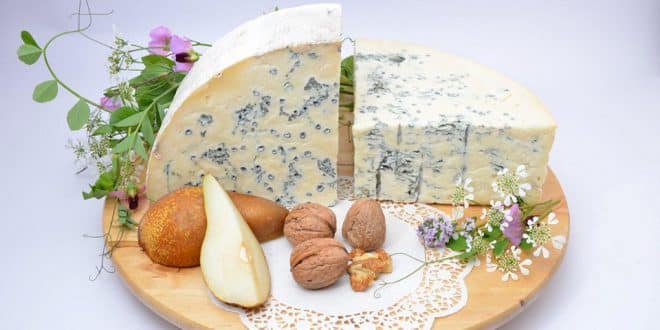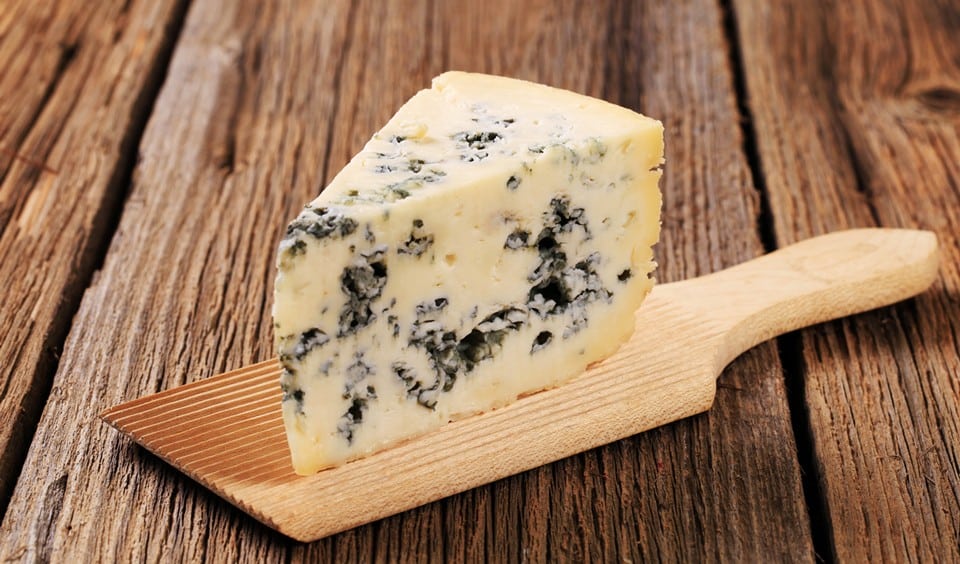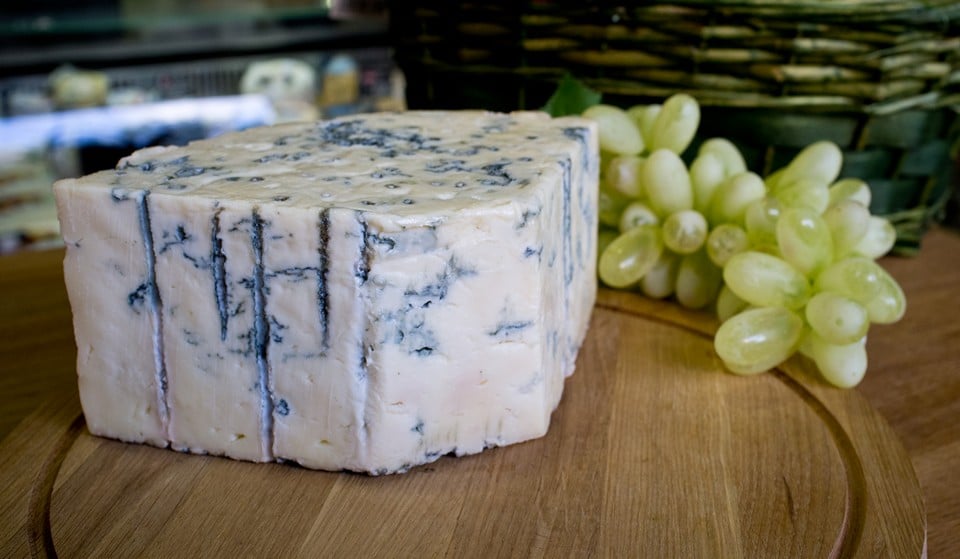Gorgonzola cheese, an Italian relative of the famous French Roquefort, shares not only a similar age (they are considered the oldest blue-veined cheeses) but also romantic legends surrounding their origins. Let’s dive into the magnificent world of blue cheeses and get to know noble Gorgonzola a little better.
Page Contents
History and Description of the Cheese
The birthdate of Gorgonzola is so far removed from our time that numerous debates continue regarding its place and time of origin. As a result, its history is intertwined with a multitude of speculations.
According to some sources, cheese was first produced in the year 879 in a village bearing the same name, located near Milan (Milano). Others claim that the town of Valsassina, known for several centuries as a cheese-making hub due to the presence of natural caves with an average air temperature of 6-12 degrees Celsius, is the true birthplace of the cheese.
Legend has it that a lovestruck young man, eager to spend time with his beloved, left his evening task of making cheese unfinished. In the morning, in an attempt to hide his mistake, he mixed the curd obtained the previous night with fresh milk. Several weeks later, the young man noticed blue veins running through the matured cheese and, upon tasting it, realized he had made a discovery.
In his book “Cheese Primer,” Steven Jenkins suggests that the young man was actually preparing another Italian cheese called Stracchino when he stumbled upon Gorgonzola. Essentially, the original name for true Gorgonzola was something like “Stracchino from Gorgonzola,” later evolving into “green Stracchino.” Furthermore, it was produced during the autumn when cows returned from mountain pastures.
The production and distribution of this cheese began in two regions: Lombardy (Lombardia) and Piedmont (Piemonte), and it progressed more slowly compared to other varieties. Initially, it was produced in the cities of Pavia (Pavia) and Novara (Novara), and later, Como (Como) and Milan (Milan) joined in.
The beginning of the 20th century marked the starting point of Gorgonzola’s spread. There are records of exporting over 10,000 tons to Germany, the United Kingdom, and France. The English preferred the soft, slightly spicy white Gorgonzola, while the French and German residents ordered the tangy double-pressed cheese with numerous blue veins.
After the end of World War II, a recipe for producing Gorgonzola using the “single-pressing” method was developed. This new technique became more affordable, hygienic, and of higher quality.
Cheese factories spread throughout the Po Valley. However, in the 1970s, small-scale factories were closed due to financial constraints. From 1955 to 1977, legislative measures were taken to define the regions authorized to produce Gorgonzola cheese.
Currently, there are only 30 dairies producing authentic cheese. Approximately 45% of the cheese is made in Novara, 22% in Pavia, and 15% in Milan.
Production Technology
By law, authentic Gorgonzola is only produced in two provinces of Italy: Lombardy (Bergamo, Brescia, Como, Cremona, Lecco, Lodi, Milan, Monza, Pavia, Varese) and Piedmont (Novara, Vercelli, Cuneo, Verbania, Verbano-Cusio-Ossola, Casale Monferrato). Only milk obtained from these regions is used for its production.
The production of this cheese is a modern, automated process. Whole cow’s or goat’s milk is salted and coagulated by adding liquid rennet at a temperature of 28-36 degrees Celsius (82-97 degrees Fahrenheit). The milk is then inoculated with spores of the penicillium glaucum or penicillium roqueforti mold. The resulting curd is placed in special cylindrical containers lined with natural fabric. To remove excess whey, the forms are periodically turned.
After draining the liquid, the cheese heads are rubbed with sea salt to develop the final flavor of Gorgonzola and then placed in warm rooms with controlled humidity. After one week, the taste and consistency of the cheese are checked. If everything meets the quality standards, the cheese heads are pierced using special equipment to create air channels that promote the growth of fungal colonies. Gorgonzola is then moved to a cooler room for further aging, where the mold begins to grow intensively.
The ripening process for soft cheese lasts at least 50 days, while for spicy version, it takes at least 4 months. An authentic cheese can be recognized by the packaging foil marked with the letter “g”.
How and with what is Gorgonzola eaten?
It is a straw-white soft cheese with greenish veins. It has a creamy and soft taste with a distinctive aroma. The cheese comes in two varieties:
- Gorgonzola Dolce – a young, soft cheese with a paste-like consistency, marbled with blue veins. It has a sweet and soft taste with a delicate nutty note.
- Gorgonzola Piccante – a denser and more crumbly cheese with more blue veins than the soft cheese. It has a spicy and deep flavor with an intensified aroma.
Gorgonzola is a “living” product, and its aging process never stops. Therefore, it is recommended to purchase it in quantities that can be consumed within a few days. Piccante can be stored for a longer time than Dolce.
Before consumption, it is advised to take the cheese out of the refrigerator at least 30 minutes in advance. During this time, it will acquire the desired consistency and reveal all its flavor qualities.
Both varieties of Gorgonzola are excellent for preparing both simple and complex recipes. The soft cheese adds a light tang, while the Piccante imparts a pronounced aroma of Gorgonzola to dishes. Dolce cheese, thanks to its paste-like consistency, is often used for sandwiches.
Ризотто, поленто и паста с горгонзолой – одни из любимейших итальянцами блюд. Сыр великолепно сочетается с овощами, фруктами и орехами. Горгонзола станет прекрасным аперитивом к вину:
Risotto, polenta, and pasta with Gorgonzola are among the Italians’ favorite dishes. The cheese pairs wonderfully with vegetables, fruits, and nuts. It makes an excellent appetizer with wine:
- Dolce highlights the aroma of soft and dessert fortified wines.
- Piccante complements robust and full-bodied wines.
And, of course, sauces and soufflés with the addition of Gorgonzola will be unmatched.
Recipe for “Gorgonzola” Sauce:
Приведём вашему вниманию простой рецепт оригинального, вкуснейшего соуса с итальянским сыром.
Растопите 3 столовые ложки сливочного масла, добавьте в него 60 г сыра горгонзола, мелко нарезанный зелёный лук, натертый зубчик чеснока и щепотку черного перца. Подавать к мясу. Минимум компонентов, максимум вкуса!
Caloric content and beneficial properties:
Gorgonzola is a cheese made without additives and preservatives. Thanks to strictly controlled production and milk pasteurization, the safety of the cheese and the preservation of its taste qualities are guaranteed.
Chemical composition
The nutritional value of 100 g of cheese is as follows:
- Carbohydrates: about 0 g;
- Proteins: 18 g;
- Fats: 27 g;
- Salt: 1.6 g;
- Calcium: 530 mg;
- Phosphorus: 280 mg.
Beneficial properties
- Gorgonzola is an excellent food product for athletes. During the cheese making and aging process, the breakdown of milk proteins into free amino acids occurs, which are easily absorbed and utilized by the body for protein synthesis.
- The peptides discovered by scientists in Gorgonzola cheese act as antithrombotic factors, regulate the functioning of the gastrointestinal tract, have immune-stimulating functions, and normalize blood pressure.
- Calcium, which is present in the cheese, has high bioavailability, meaning it is quickly absorbed by the body. This is particularly important for children during periods of rapid growth and for the elderly to prevent the development of osteoporosis.
- During the cheese-making process, lactic acid bacteria digest lactose. Therefore, properly aged Gorgonzola contains only traces of this substance. As a result, the cheese is well tolerated by individuals with lactose digestion problems.
- Due to its creamy texture, there is a misconception that Gorgonzola is a high-fat product. This is not true. Comparing the values shows that the fat content in Gorgonzola is comparable to other cheeses that are perceived by consumers as lighter.
- The presence of mold microorganisms leads to the formation of free fatty acids such as lauric, palmitic, stearic, and oleic acids. They play an important role in suppressing pathogenic microorganisms and contribute to extending the shelf life of the cheese.
Of course, Gorgonzola is not a medication, but this Italian cheese undoubtedly fits well into a balanced and healthy diet.
Price in Italy
Currently, the total production volume of authentic Gorgonzola cheese exceeds 48,000 tons per year. The retail turnover surpasses 500 million euros.
Since cheese has a limited shelf life, it is primarily sold in small packaging.
In Italy, on average, this cheese can be purchased for about 6 to 9 euros per 250 grams (24-36 euros per kilogram).
Our acquaintance with Gorgonzola has come to an end. While enjoying your time in Italy, don’t miss the opportunity to try this blue-veined cheese. Let mold remain only on cheese and let it be of the noble kind!
Interesting Facts about Gorgonzola
- Gorgonzola, known as the “blue cheese of kings,” has a fascinating history dating back to the 9th century. It was first produced in the town of Gorgonzola in Lombardy, Italy, and has since become one of the country’s most iconic cheeses.
- The unique blue veins in Gorgonzola are a result of the cheese being pierced with thin metal rods during the aging process. This allows the growth of Penicillium mold, which imparts the distinct blue-green marbling and adds complex flavors to the cheese.
- Gorgonzola comes in two varieties: Dolce (sweet and creamy) and Piccante (sharp and pungent). The Dolce version is aged for a shorter period, resulting in a milder taste, while the Piccante is aged longer, intensifying its robust and tangy flavor.
- Legend has it that Gorgonzola was discovered accidentally when a forgetful cheesemaker left a batch of fresh cheese in a damp cave. The cheese aged and developed blue mold, giving birth to Gorgonzola’s unique characteristics.
- Gorgonzola’s rich and creamy texture makes it a versatile cheese that can be enjoyed in various ways. It pairs beautifully with fruits like pears and figs, balances the flavors of risotto and pasta dishes, and adds a gourmet touch to salads and sandwiches.
- Italy celebrates Gorgonzola with a dedicated festival called “Sagra del Gorgonzola.” (www.gorgonzolacavallermaggiore.it) Held annually in the town of Gorgonzola, this festival showcases the cheese’s heritage, culinary traditions, and local artisanal production.
- Gorgonzola is not only a delight for the taste buds but also a source of nutrition. It is packed with essential nutrients like calcium, protein, vitamins, and minerals, making it a flavorful and wholesome addition to a balanced diet.
 Italy for me From Italy with love
Italy for me From Italy with love






